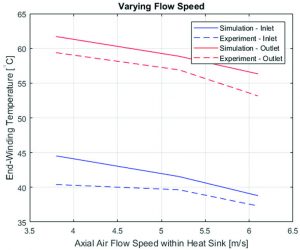Multi-Physics Optimization of High-Frequency Air-Core Permanent-Magnet Motor for Aircraft Applications
Xuan (Melody) Yi with adviser K. Haran
The aviation industry demands environmentally friendly and fuel-efficient aircraft to be sustainable. It has been theoretically shown that superconducting machines can power electric airplanes to carry hundreds of people. These machines apply superconducting technology to produce dramatically high flux density  and high current density, and thus reduce weight and volume. Conventional machines for aircraft applications must reach a power density of 8 hp/lb (four times greater than the existing state-of-the-art) to produce similar results. In this project funded by NASA and the Grainger Foundation, a non-cryogenic, high-frequency, high-pole-count, high-speed air-core permanent magnet motor is proposed to meet this requirement. In addition, an efficient multi-physics optimization method that can accurately predict electric and thermal performance of such a machine is developed and verified with finite element analysis. Optimum machine sizing of the machine is obtained by using a genetic algorithm coupled with an established multi-physics model requirement.
and high current density, and thus reduce weight and volume. Conventional machines for aircraft applications must reach a power density of 8 hp/lb (four times greater than the existing state-of-the-art) to produce similar results. In this project funded by NASA and the Grainger Foundation, a non-cryogenic, high-frequency, high-pole-count, high-speed air-core permanent magnet motor is proposed to meet this requirement. In addition, an efficient multi-physics optimization method that can accurately predict electric and thermal performance of such a machine is developed and verified with finite element analysis. Optimum machine sizing of the machine is obtained by using a genetic algorithm coupled with an established multi-physics model requirement.
Currently, the MW prototype has been developed and the full-power test will happen in the short term. Part of the analytical models that are built within the multi-physics motor sizing tool has been validated with the MW prototype. For example, a stator thermal test has been conducted to verify the thermal conduction and heat transfer effects of cooling channels in the developed thermal model.
Figure 9 illustrates the stator thermal test setup where the full-size stator was wrapped with thermal insulation and a wind tunnel and fan were set on the top. All the coils of the stator were fed with the same amount of current. Temperatures were monitored along with various fan flow speed and heat loss. Figure 10 shows both prediction and experimental results have good agreement.

